
Related
Guests
- Lorna Vassellmother of Saheed Vassell, an unarmed, mentally troubled African-American man shot in Brooklyn on April 5 by New York Police Department officers.
- Eric Vassellfather of Saheed Vassell, an unarmed, mentally troubled African-American man shot in Brooklyn on April 5 by New York Police Department officers.
We continue our conversation with the parents of Saheed Vassell, who are calling for justice after New York police officers responding to a 911 call shot dead their son, an unarmed, mentally troubled African-American man, on a street corner in Brooklyn on April 5. At the time of his death, Vassell was holding a metal pipe that police say they mistook for a gun. The NYPD said four officers—three in plainclothes and one uniformed—fired 10 rounds at Vassell, a Jamaican immigrant. None of the officers who opened fire were wearing body cameras. The Vassell family is now calling for the release of all unedited video from the area leading up to and during the shooting.
Transcript
AMY GOODMAN: This is Democracy Now!, democracynow.org, The War and Peace Report. I’m Amy Goodman, with Part 2 of our discussion about the police officers who responded to a 911 call on April 5th in Brooklyn and shot dead an unarmed, mentally troubled African-American man on a street corner in Brooklyn. At the time of his death, Saheed Vassell was holding a metal pipe that police say they mistook for a gun. The NYPD says four officers—three in plainclothes, one uniformed—fired 10 rounds at Saheed Vassell, a Jamaican immigrant. Resident Kevin Davis witnessed the shooting by officers, who arrived in an unmarked car. He described what he saw to the New York Daily News.
KEVIN DAVIS: He walked across the street with the thing in his hand. The cops’ car was coming up the street. They take a U-turn. They came out of the car. They didn’t say, “Freeze.” They didn’t say, “Drop your weapon.” In two seconds, all four cops started shooting. They killed him.
EDGAR SANDOVAL: Was there like any exchange of words?
KEVIN DAVIS: No, no words. No words exchanged. Nothing.
EDGAR SANDOVAL: What went through your mind when you were seeing this?
KEVIN DAVIS: When I saw they come up and I saw them make the U-turn, I said to my friend, “Oh, damn. The cops.” I started to hold up my hands, trying to get their attention, to let them know that, you know, it’s nothing serious. In two seconds, they started shooting.
AMY GOODMAN: “In two seconds, they started shooting,” he said. New York State Attorney General’s Office is now investigating the fatal shooting. A recent study found the Crown Heights neighborhood of Brooklyn, where Saheed Vassell was killed, is one of the 20 most gentrified areas of the country. When over a thousand protesters gathered at the scene of his death, many longtime residents expressed concerns that 911 calls from new residents in the area have contributed to the criminalization of longtime, low-income residents of color, especially black men.
At first, the New York Police Department released edited surveillance video of Vassell’s actions prior to his death. Then, after pressure, they released video showing the police officers shooting Vassell. None of the officers who opened fire were wearing body cameras. The Vassell family is now calling for the release of all unedited video from the area leading up to and during the shooting.
We continue with our conversation with Saheed Vassell’s parents, Lorna and Eric Vassell.
Lorna, talk about what you are looking for right now.
LORNA VASSELL: I want all video to release to the public with Saheed. The NYPD, they murdered Saheed, and they put out video of Saheed action. We want to see the action of the police that murdered my son.
AMY GOODMAN: Now, explain what you understand took place. Of course, you weren’t there.
LORNA VASSELL: I were not there.
AMY GOODMAN: But what you understand at that moment. I mean, you have this bystander saying he wanted to tell the police, wave to them, “Don’t do something.”
LORNA VASSELL: “Don’t shoot him.”
AMY GOODMAN: But within seconds—
LORNA VASSELL: He said, within second, they have already gunned him down.
AMY GOODMAN: And what did you understand he had in his hand?
LORNA VASSELL: A shower head. That’s what I heard, that he have a shower head into his hand. And it was broad daylight.
AMY GOODMAN: Eric Vassell, your son was a solderer? He did it as a trade? He worked with pipes?
LORNA VASSELL: Yes.
ERIC VASSELL: Yeah, he works at the—
LORNA VASSELL: He’s a welder.
ERIC VASSELL: —as a welder. He works as a welder. But my point is that the police say he had something in his hand, and the eyewitnesses say he did not have nothing in his hand. So, that’s where eye lies. I want to see, you know, because there are witnesses say he did not have anything in his hand. But I want the names of the four officers. We want to hear about their background. And we want justice for our son. That’s all we are looking. Release all the video.
LORNA VASSELL: Yes.
ERIC VASSELL: Show us a video with my son with the pipe in his hand.
LORNA VASSELL: In his hand.
AMY GOODMAN: Now, there is clearly a lot of video out there, because this is a commercial area. What time was it when your son was killed?
LORNA VASSELL: 4:45.
ERIC VASSELL: 4:45.
AMY GOODMAN: It’s light outside.
ERIC VASSELL: It’s light outside.
LORNA VASSELL: Broad daylight.
AMY GOODMAN: So there is a lot of video.
ERIC VASSELL: There’s a lot of video. There is a—
AMY GOODMAN: Now, the mayor said, well, it’s based on what the state attorney general wants, but Eric Schneiderman’s office said they’re not getting in the way of video being released.
ERIC VASSELL: Yes, but they released video of my son. So, as long as they can release video of my son, then therefore they should reveal the video of the police.
LORNA VASSELL: The police officers.
ERIC VASSELL: And the only thing—
LORNA VASSELL: And their action.
ERIC VASSELL: The other thing, they don’t show no video of my son pointing the pipe at the police.
LORNA VASSELL: Police.
ERIC VASSELL: They show us video of him pointing it at somebody else. So show me the video when they pointed at the police.
LORNA VASSELL: When he pointed at the police.
ERIC VASSELL: And the police kill him in action.
AMY GOODMAN: You’re talking about the shower head.
LORNA VASSELL: Yes, the shower head.
ERIC VASSELL: Yes, the shower head.
AMY GOODMAN: And how that image of him with a shower head relates to the timing of the police coming.
ERIC VASSELL: Timing of the killing. That’s what we are looking for. That’s exactly what we are looking for, the timing that, OK, you spoke to him and then say, “Hold, stop it,” and he turns around. That’s what I want to see. He turns around, he faces them, and they fired, because they claim that they were afraid for their lives. Show us that video, because it’s—there’s a lot of cameras around. So show us all the video—where the police was coming from, how they make the turn, when—let us hear some sound where you call to the young man, “Drop your weapon,” and he turned around.
AMY GOODMAN: Also, if he had a shower head or not, how far were the police from him?
LORNA VASSELL: We don’t know that.
ERIC VASSELL: We don’t know how far the police were from him.
LORNA VASSELL: We don’t know how far the police.
ERIC VASSELL: But all I know, that if there are cameras, the camera is supposed to pick up every single action, not part and part. Show us a full video.
AMY GOODMAN: So, you’re saying what they have released is just to incriminate your son.
ERIC VASSELL: Just to incriminate my son. Just—
LORNA VASSELL: Just to incriminate Saheed.
AMY GOODMAN: And so, you’re willing—you’re saying you want to see everything, whatever it shows.
LORNA VASSELL: Everything.
ERIC VASSELL: Everything.
LORNA VASSELL: We want to see everything.
ERIC VASSELL: Show us the movie.
LORNA VASSELL: Show us. Show us. Show us.
ERIC VASSELL: Because—yes.
AMY GOODMAN: Have any store owners come up to you and said they have video?
ERIC VASSELL: No.
LORNA VASSELL: They say the police have already—
ERIC VASSELL: They already take those.
AMY GOODMAN: Collected the video.
LORNA VASSELL: Collected all the video, their camera.
AMY GOODMAN: All the closed-circuit camera—
LORNA VASSELL: Yeah, all their cameras. The police have already collect all the cameras. Every single one. So that there have to be the police kill Saheed, and what Saheed was showing to them.
AMY GOODMAN: Have you heard the 911 calls?
ERIC VASSELL: We don’t hear the 911 call.
LORNA VASSELL: I don’t. I don’t.
AMY GOODMAN: I mean, clearly, a number of people called.
ERIC VASSELL: No.
LORNA VASSELL: No, I don’t.
ERIC VASSELL: No. So we are demanding that we hear the 911 call. We are demanding that the names of the police officers should be released. We are demanding that all video should be released.
AMY GOODMAN: They’ve only released one still of your son without anyone there, just your son.
LORNA VASSELL: Son.
ERIC VASSELL: Just my son.
LORNA VASSELL: So we want the—with the police.
ERIC VASSELL: So we want all video. I am not—
LORNA VASSELL: And their action.
ERIC VASSELL: I am not interested in pictures. I am interested in videos, because a video can show the actual action of my son interacting with police.
AMY GOODMAN: What did it mean to you that a thousand people turned out in the protest of Saheed’s killing?
LORNA VASSELL: I feel so good. We get the support from the neighborhood. I did not know so many people love Saheed. I was—one morning, the day after Saheed died, I heard a knock on my door. I went out. There was a lady, about 84 years old. She came walking with a walker. She said, “I came to give my condolence to Saheed’s parents. Are you Saheed’s mom?” I said, “Yes.” The lady said—I never met this lady before. She said, “Saheed was such a wonderful person. Saheed could go get my grocery for me. Anything I want Saheed to do, Saheed would never take a cent of my money. He would bring back every change to me.”
Yesterday, another lady, about over 80 years old, went to church, asked someone where we live. The lady came back yesterday. She said, “I can’t believe they killed that young man. That young man is such a good young person. He’s one of the best person I have ever seen.”
And they’re going around, trying to put Saheed down, as if Saheed was such a bad person in the neighborhood.
Saheed was loved by everyone in Crown Heights. Saheed was one of the funniest person you could ever come across. If you see Saheed, he will say, “I love you.” A lady came to me. She said, “Saheed always see me and said, 'Empress.'” That’s how the way he react to everyone in the neighborhood.
AMY GOODMAN: When is the funeral for your son?
ERIC VASSELL: Funeral, the viewing will be on Thursday the 19th. The reflection, the burial will be on Friday. But let me say this. He was a wonderful, wonderful young man. And I, as a father, won’t say that my son was this and that. The community—
LORNA VASSELL: Will tell you.
ERIC VASSELL: —speak for itself. I don’t have to give a story about him, exactly who he was, because the story that I heard, I did not know my son as much as how the community know him. And for them to take his life, the community is mourning for the loss of Saheed Vassell. And me, my wife, the community is asking for justice.
LORNA VASSELL: For justice.
ERIC VASSELL: And I’m asking the mayor and the Attorney General Office that we are looking justice, and they also must stand with us and look justice for Saheed Vassell.
AMY GOODMAN: I want to thank you both for being with us, coming to Democracy Now! today, Lorna and Eric Vassell, the parents of Saheed Vassell, who was killed by New York police on April 5th. To hear Part 1 of our conversation, you can go to democracynow.org. I’m Amy Goodman. Thanks so much for joining us.

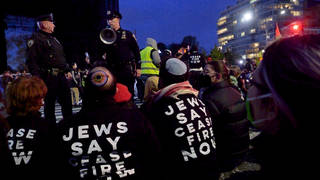
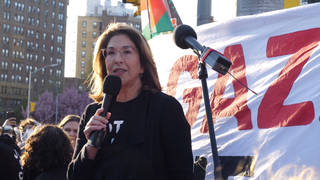
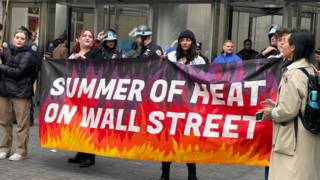
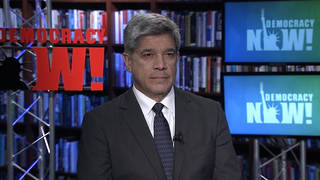





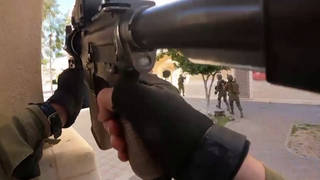
Media Options